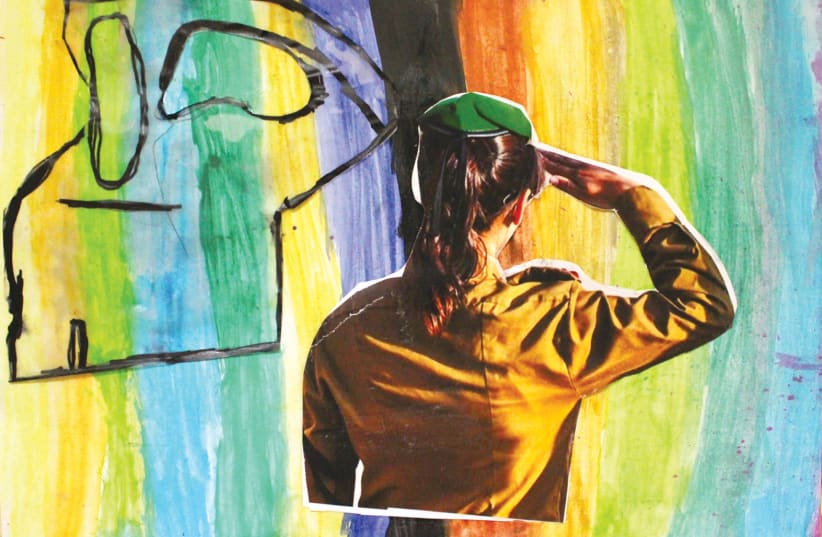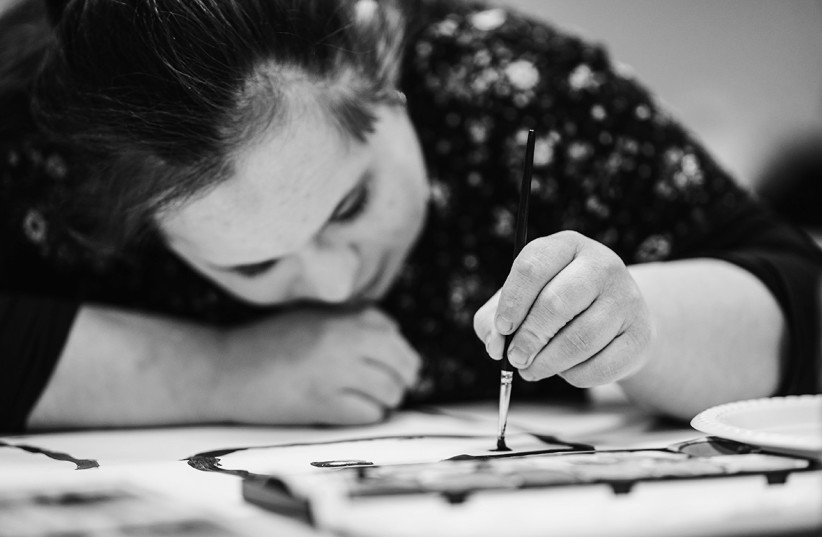Entering the exhibition hall, one is instantly struck by the powerful emotions emanating from the works of art on display. It’s an intriguing assortment of styles, mostly watercolors and pastels, with others incorporating elements such as layers of construction paper and cutouts. There is a hush in the room, with an aura of complexity and tumultuous feelings of pain and loneliness, along with faint glimmers of hope and prayer for the return of safety and peace.
No, this exhibition is not the work of world-renowned artists or painters, nor is it featured in a ritzy gallery in Paris, Manhattan, or Rome. It is the self-expression of adolescents and adults with mild to severe cognitive disabilities, displayed in Jerusalem’s National Shalva Center’s traveling art exhibition.
With Israel now in its third month of war, a significant number of Israelis – adults and children alike – are suffering from trauma and struggling to process their pain, grief, and fear. Over 1,200 innocent Israelis are dead, while over 100 are still being held hostage. Thousands more, many of whom have been displaced, are still struggling to come to terms with their wounds. And all the while, the media delivers daily heart-rending reports of fallen soldiers from the front lines.
Finding self-expression during Israel-Hamas war
Finding a means of self-expression amid the tumult of war is a formidable challenge, as words often fall short of encapsulating the profound emotions that accompany these traumatic times. This struggle is more profound for people with disabilities, for whom communication is an ongoing battle.
“During these times, finding methods of communication and expression is all the more critical,” says Rabbi Kalman Samuels, founder and president of Shalva, Israel’s premier center for children and adults with disabilities.
Since its founding over 30 years ago, Shalva National Center in Jerusalem has served as an oasis, bringing comfort to thousands of young people and adults with a range of physical and mental disabilities and their families. Aside from offering educational and therapy services to Israel’s community of individuals with disabilities, the 11-story Shalva National Center was also constructed as a National Crisis Center, complete with beds, equipment, and dry goods that can safely accommodate and sustain 1,200 refugees for a full month in times of national crises.
Since October 7 and the outbreak of war, Shalva Center has become a safe haven for terror victims, absorbing approximately 1,000 families and students from Gaza border communities. In addition, it serves as a refuge for displaced children and adults, including many with disabilities. Some are currently residing in Shalva’s Crisis Center, while others are being put up in apartments and hotels in the Greater Jerusalem area, with no immediate plans to return home. The common denominator among them all is a need to navigate and articulate their complex emotions.
“When war broke out and Shalva was flooded with a whole new group of disabled adults and children in need of assistance, we welcomed them with open arms. Some have endured serious trauma. Seeing how badly they – along with many of our regular participants, many of whom are also suffering various degrees of confusion or trauma due to recurring sirens, wounded family members, or a father in the reserves, etc. – needed outlets for their emotions, we turned to our amazing art therapy staff,” says Sophie Weiss, a project associate at Shalva.
OVER THE past few weeks, Shalva’s art therapists have guided adolescents and adults to express their feelings through a variety of art forms. “When they sit and draw, they are able to express their feelings in ways they can never articulate. Emotions like worry, fear, the expectation, the hope of returning to normal, the prayer that everything should be all right are all being communicated nonverbally, with a crayon and paintbrush,” says Avital Sternberg, art therapist at Shalva.
Nadav is a teenager on the autism spectrum who was evacuated from Ashkelon and is currently staying in Jerusalem with his family until they can safely return home. He joined Shalva’s program, where his mother says the art therapy classes have helped him emerge from the shell he entered on that dark day, Oct. 7.
Nadav first began expressing his fear of falling rockets while using a paintbrush to portray the earsplitting blasts in bold, angry colors – reds, oranges, and plumes of gray. “It was very, very scary,” he said.
Through the art therapy program, Sternberg, her colleagues, and Shalva’s teen and adult artists with Down syndrome, autism, and a range of other disabilities have crafted a striking exhibition titled Living through War – an Exhibit of Hope. This powerful display delves into various aspects of the artists’ emotions in relation to the war, Israel, the IDF, and everyday life since October 7. Each piece serves as a poignant expression of thoughts and feelings during wartime.
Beyond offering personal catharsis to the artists, the exhibition also plays a crucial role in presenting to the international community the profound experiences of Israelis living through war. It provides a raw and deep insight into the pain and suffering and, notably, the hope and resilience that follow. The exhibition was designed to travel internationally so that these deep insights into the war could be shared with the world.
Arts executive Sara Samuels, who works with Shalva’s teenage artists, emphasizes the necessity of sharing this exhibition worldwide: “I think it’s crucial for people around the world to understand and sympathize with the personal experiences of individuals in Israel. Highlighting the unique perspective of artists with disabilities offers the international community a rare opportunity to glimpse how they are coping with the trauma that all Israelis are living through right now.” ❖













